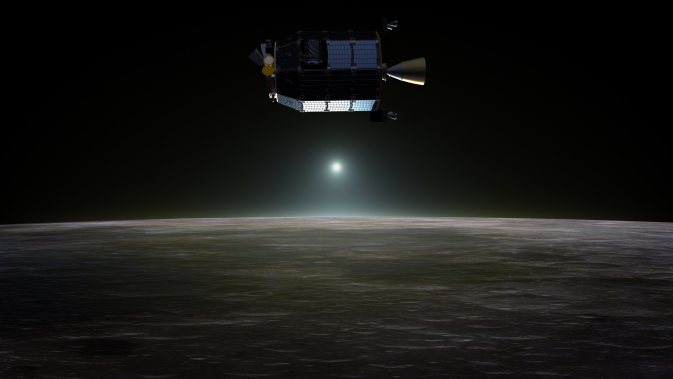
Although somewhat neglected by the media, partly because of its lack of any grabbing and impressive space imagery, as opposed to other ongoing lunar exploration missions, NASA’s Lunar Atmosphere and Dust Environment Explorer, or LADEE, is currently investigating some really interesting scientific questions regarding our closest celestial neighbor. The spacecraft recently passed an important milestone in its mission by concluding its initial 100-day primary phase of observations earlier this month, while entering an 28-day extended mission phase.
Contrary to the thick atmosphere that envelops the Earth, the Moon is better known for being an airless celestial body. Nevertheless, our natural satellite is surrounded by a tenuous atmospheric layer of its own, consisting of dust particles and trace amounts of various chemical elements, called the exosphere. Technically, the exosphere is the outermost layer of the atmosphere around a planet or moon. It is not an abrupt boundary where the atmosphere suddenly stops, rather a gradual thinning out and merging with interplanetary space.
In the case of the Earth, the exosphere begins at a height of more than 600 km above the ground, an altitude higher than that of the International Space Station and of every other mission that has taken place in low-Earth orbit for the past 40 years. On the other hand, and because of its lower gravity and mass, the Moon lacks the ability to have a stable, thick atmosphere like the Earth’s. Thus, it is only surrounded by an atmosphere with a density less than one hundred trillionth that of the Earth’s at sea level, which for all intents and purposes can be considered as a near-perfect vacuum. In the absence of any intermediate atmospheric layers, this ultra-thin layer extends all the way down to the lunar surface, which scientists call a “surface boundary exosphere.”
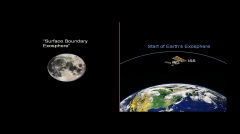
“Sometimes we get a little surprised when we start talking about a lunar atmosphere, for most of us were taught in school that the Moon doesn’t have an atmosphere,” said Sarah Noble, program scientist for the mission at NASA’s Headquarters in Washington, D.C., during a pre-launch press conference. “It does, but it’s very, very thin. It’s so thin, that the individual molecules that make up the atmosphere never see each other. They don’t interact, they don’t collide. And the Moon is not the only example we have [for this type of atmosphere]. Mercury, a lot of the moons of the outer planets, as well as some of the larger asteroids in our Solar System, all have surface boundary exospheres [like the Moon]. It turns out to be the most common atmosphere we have and yet it’s one that we don’t really know much about. LADEE is a really great opportunity to go and learn not only about the Moon, but about many of the bodies in our Solar System.”
The source of this rarefied exosphere is thought to be a combination of outgassing of different chemical elements from the lunar surface, either coming from the interior of the Moon itself or through meteoric impacts on the surface and the constant bombardment of the Moon by the solar wind that flows through interplanetary space. Its composition had been studied in-situ for the first time during the Apollo missions of the late 1960s and early 1970s. The astronauts of Apollo 17, the last manned mission to land on the Moon in 1972, deployed a mass spectrometer on the lunar surface called the Lunar Atmospheric Composition Experiment, or LACE, which took measurements of the trace chemical elements of the lunar exosphere.
The measurements made during Apollo showed that the atmosphere of the Moon had trace amounts of hydrogen, helium, oxygen, water, carbon dioxide, argon, and other small amounts of noble gases. The significant discovery in recent years of water ice deposits on the bottoms of permanently shadowed craters on the Moon’s south pole by India’s Chandrayaan spacecraft and NASA’s Lunar Crater Observation and Sensing Satellite, or LCROSS, opened up the possibility for the existence of a lunar “water cycle” of sorts. As an alternative to the cometary impact hypothesis, scientists now theorise that water molecules might constantly be deposited on the lunar surface through a perpetual process of evaporation, condensation, and migration toward the deep craters of the polar regions, where water ice can be collected and preserved.
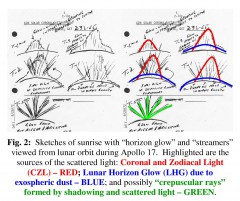
To further investigate the conditions and intriguing dynamics of the Moon’s tenuous atmosphere and dust environment near the lunar surface, the $280 million LADEE mission was designed by NASA in 2008 as a precursor for the extended manned lunar exploration missions that were conceived at the time as part of the agency’s now-cancelled Constellation program.
Launched on Sept. 6, 2013, LADEE reached the vicinity of the Moon a month later, following a slow cislunar cruise. Having entered lunar orbit on Oct. 6, the spacecraft spent the following 30 days going through a series of system and instrument tests during a commissioning and checkout phase, prior to the start of its primary science mission on Nov. 20. For the duration of its mission, LADEE was kept at a circular lunar orbit, with a periselene of 20 to 50 km and an aposelene of 75 to 150 km in order to investigate the atmospheric environment as close to the lunar surface as possible. Because of the Moon’s highly irregular gravity field, which would cause LADEE’s orbit to be degraded over time, the spacecraft had to perform powered Orbit Maintenance Maneuvers every week, so as to be kept at the altitude needed for its science mission.
LADEE’s science payload consists of three instruments: an Ultraviolet and Visible Light Spectrometer, or UVS, for determining the chemical composition of the lunar atmosphere; a Neutral Mass Spectrometer, or NMS, for measuring variations in the lunar atmosphere over multiple lunar orbits; and a Lunar Dust Experiment, or LDEX, for the collection and analysis of dust particles in the tenuous lunar atmopshere near the surface.
During the 100-day primary mission phase, the UVS instrument onboard LADEE has acquired more than 700,000 spectra of the Moon’s atmosphere, while the NMS has helped to identify the presence of certain chemical elements like argon-40, which had also been identified by the crews of the Apollo missions, as well as neon-20, potassium, and helium. Since arriving at lunar orbit in October 2013, the LDEX instrument has also recorded more than 11,000 collisions of dust particles on its sensors.
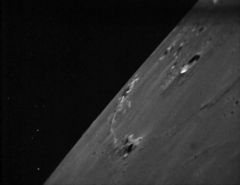
Preliminary analysis of the science data gathered so far shows a periodic variation of sodium around the Moon, which seems to be tied to our natural satellite’s orbit around the Earth. LADEE has measured a systematic increase in the presence of sodium during the waxing Moon and a following decrease when the Moon is waning.
The spacecraft also found out that the flow of helium on the lunar surface, which is constantly replenished by solar wind particles, is interrupted whenever our natural satellite crosses the Earth’s geomagnetic tail. “Earth’s magnetotail extends well beyond the orbit of the Moon and, once a month, the Moon orbits through it,” says Tim Stubbs, a scientist at NASA’s Goddard Space Flight Center. “If the Moon is full, it is inside the magnetotail. The Moon enters the magnetotail three days before it is full and takes about six days to cross and exit on the other side. This can have consequences ranging from lunar ‘dust storms’ to electrostatic discharges.” During the time that the Moon crosses the Earth’s magnetotail, the whole lunar night side receives a widespread negative electric charge, from the energetic particles coming off the Earth’s magnetosphere. It is thought that this build-up of free electrons on the lunar night side can cause dust to float freely above the surface, even creating “dust storms” of particles migrating from the highly charged lunar night side to the lower-charged day side. This theory is backed up by photographic evidence from NASA’s unmanned Surveyor 7 that landed near the edges of Tycho crater, at the southern highlands of the Moon’s near side at 1968, but hasn’t been confirmed. “Apollo astronauts never landed on a full Moon and they never experienced the magnetotail,” says Stubbs.
Nevertheless, LADEE’s LDEX instrument was able to map the variations of dust concentrations during the course of a lunar day. It has found that the layer of dust above the Moon is thicker near the surface, thinning out at increasing altitudes, while the bigger accumulation of dust occurs during the early lunar morning, when the Sun rises above the Moon.
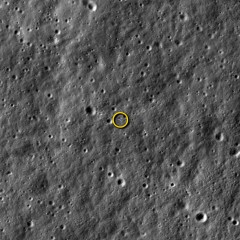
Interestingly, LADEE was unable to identify any trace elements of exhaust gases or ejected dust during the historic landing of China’s Chang’e 3 lander and Yutu rover near Sinus Iridum, or Bay of Rainbows, on Dec. 14, 2013. It was thought that the arrival of Chang’e 3 would disrupt the pristine condition of the lunar atmosphere and the dust environment near the surface. LADEE had the unique chance to obtain “before” and “after” measurements around the landing site. Yet it failed to detect any elevated levels of dust there. What it did detect was increased levels of dust impact rates, several hours before the actual landing itself. The timing of the elevated dust levels coincided with the peak of the Geminid meteor shower a day earlier, on Dec. 13. These observations from LADEE indicate that the landing of a spacecraft the size of Change 3s fails to produce any observable effects on the surrounding lunar environment.
Science observations aside, LADEE also carried a technology demonstration payload, called the Lunar Laser Communication Demonstration, or LLCD. Its goal was the demonstration of two-way broadband optical communications between the Earth and the Moon, using a pulsed infrared laser beam instead of radio waves. The spacecraft made history on Oct. 17, 2013, by achieving an error-free communication with Earth, with a downlink transmission rate of 622 Megabits per second and an uplink rate of 20 Mbps. NASA hopes that the success of the LLCD will lead to the development and use of similar broadband optical communication systems for future manned and robotic missions throughout the Solar System, allowing for the transmission of high-definition video streams through interplanetary distances. “LLCD is the first step on our roadmap toward building the next generation of space communication capability,” said Badri Younes, NASA’s Deputy Associate Administrator for space communications at NASA Headquarters. “We are encouraged by the results of the demonstration to this point, and we are confident we are on the right path to introduce this new capability into operational service soon.”
Video Credit: NASA/Goddard Space Flight Center
Even before the successful conclusion of its primary mission, LADEE was granted an additional month of extended science operations through mid-April, due to the excellent performance of the spacecraft’s propulsion system, which led to extra fuel reserves being available for the science team. During this extended period of observations, mission planners will program LADEE to make very close passes of the Moon at a lower orbit than that of the primary mission phase, allowing scientists to get even more precise measurements of the lunar atmosphere. This doesn’t come without a big risk to the spacecraft, though, and all the dangers associated with flying at very low orbits.
Assuming a successful outcome to its extended science phase, LADEE will be intentionally de-orbited and left to impact the lunar surface, thus putting an end to the mission. Despite all the exciting science conducted, maybe the most important result of the mission will be the realisation that our understanding of the Moon is far from complete, underscoring the need for a more permanent human and robotic presence there.
Want to keep up-to-date with all things space? Be sure to “Like” AmericaSpace on Facebook and follow us on Twitter: @AmericaSpace




This was very helpful because I always wondered how dust erosion could occur around the moon. I knew that meteor disruptions could lead to some, but there appeared to be more than what you could explain with meteor impacts. The effects of the earth’s magnetosphere on the moon is very interesting. Also interesting was the indication of the moon having a water cycle. I knew they had uncovered water hidden in the craters that were never exposed to sunlight, but knew nothing of there being an actual water cycle. Fascinating stuff.
It certainly is fascinating Mike, and these are only the first preliminary results of the mission. The Moon is so much more fascinating than we currently think. There are so many things yet to explore and discover. LADEE’s findings just show the need for a permanent human presence to be established there!
Nice article.
I disagree with the truism – “…because of its lower gravity and mass, the Moon lacks the ability to have a stable, thick atmosphere like the Earth’s.”
There is not a monotonic correlation between atmosphere mass and planet mass.
Venus is somewhat less massive than Earth and has an atmosphere ninety times the mass of Earth’s.
Titan is only a little larger than the Moon, much less massive than Earth but has an atmosphere 1.2 times greater than the mass of Earth’s.
Clearly these exceptions to a trend show that there is more to planetary atmospheric creation and retention than mass or size alone will indicate.
Cheers
Great observations Bill!
Indeed, there are more factors contributing to the retention of a planetary atmosphere than the mass of a planet alone. The atomic weight of chemical elements also plays an important role. But the mass and gravity of a planet can be considered as the most important one, because it’s what defines in the end what type of atmopshere a planet will or will not have.
Venus for instance is 80% as massive as the Earth, and has an atmosphere almost 90 times as thick. Yet, this atmopshere is comprised of mostly carbon dioxide and sufuric acid. These chemical elements are several times heavier than the oxygen and nitrogen that mostly comprise Earth’s atmopshere, thus Venus, despite being less massive than Earth, can sustain such a thick atmopshere.
Also, Titan is approximately 80% more massive than the Moon, which can help explain its also rich, thick atmopshere as well.